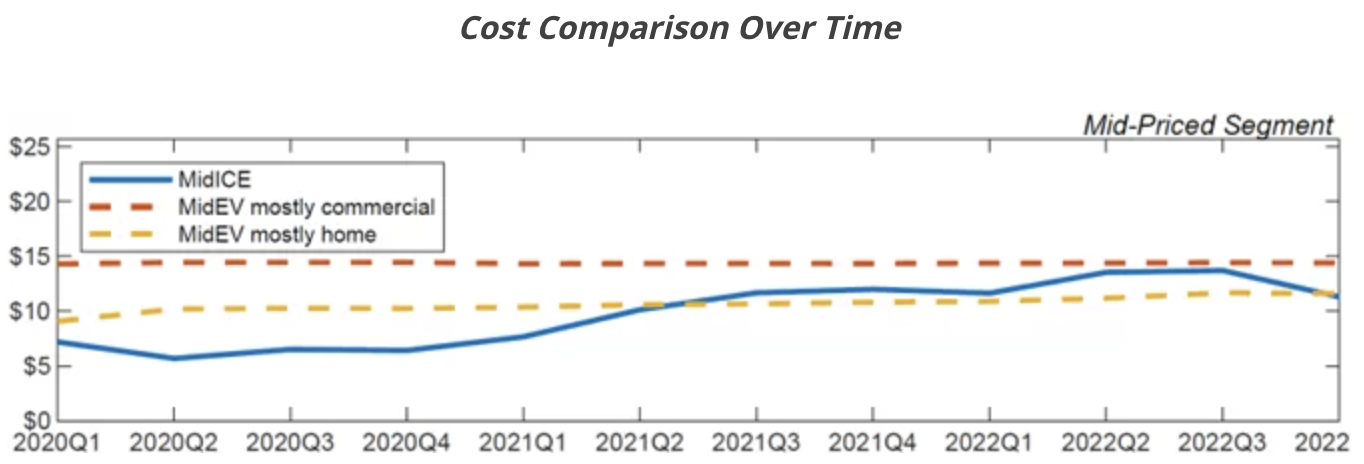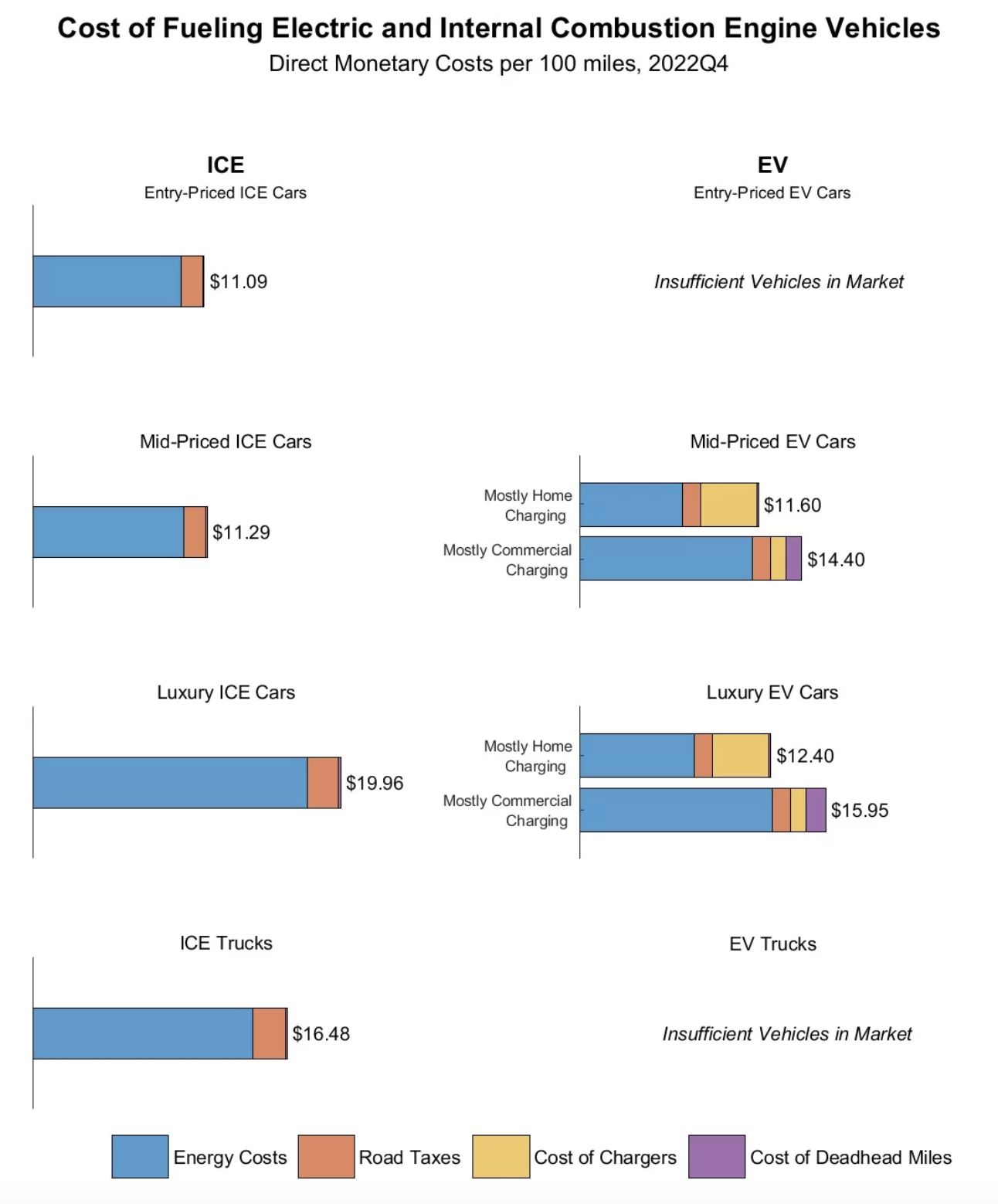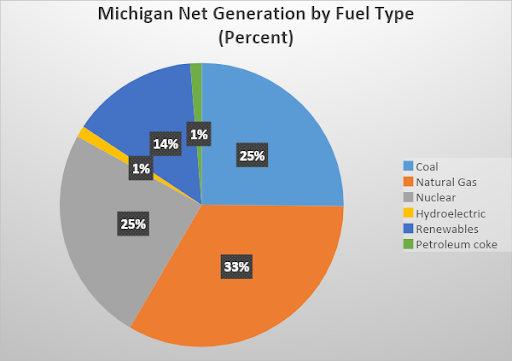A recent study by the Anderson Economic Group found the cost to fuel certain electric vehicles to be higher than similar gasoline-powered cars for the first time in 18 months. In the fourth quarter of 2022, drivers fueling a typical mid-priced Internal Combustion Engine (ICE) car paid $11.29 to fuel their vehicle for 100 miles of driving. That cost was $0.31 cheaper than the amount paid by drivers in mid-priced electric vehicles charging mostly at home, and over $3 less than the cost borne by comparable EV drivers charging commercially. This occurred because gasoline prices were declining and electricity costs were increasing. It fundamentally undermines the Biden Administration’s “whole of government” push for the electrification of transportation in the United States, exemplified in this argument for electric vehicles by Energy Secretary Jennifer Granholm.
For luxury cars, the opposite is still true. During the fourth quarter of 2022, luxury EV owners paid $12.4 to drive every 100 miles on average if they charge their cars mostly at home or $15.95 if they charge their cars mostly at commercial charging stations. The fuel costs for luxury gasoline-powered cars totaled $19.96 per 100 miles on average. Assuming mostly home charging, the cost benefit to fuel a luxury EV vs. a luxury ICE car dropped from $11.20 per 100 miles to $7.56. The fuel costs are based on real-world driving conditions including the cost of underlying energy, state taxes charged for road maintenance, the cost of operating a pump or charger, and the cost to drive to a fueling station.

The analysis calculates four categories of costs for fueling EVs and ICE vehicles across benchmarks representing real-world driving conditions, including:
- The cost of the underlying fuel (gas, diesel, electric)
- State excise taxes charged for road maintenance
- The cost to operate a pump or charger
- The cost to drive to a fueling station (deadhead miles)
All cases reflect 12,000 miles per year, with the cost of residential charging equipment amortized over five years. Calculations are based on energy prices and taxes in the state of Michigan. Benchmarks for ICE vehicle drivers assume the use of commercial gas stations. For EV drivers, there are two calculations: drivers who routinely charge at home and those who rely primarily on commercial chargers.
The information is depicted below by class of vehicle. There is insufficient market information for a comparison of electric trucks and of entry priced electric vehicles.

The Biden administration has been pushing hard for drivers to purchase electric vehicles supposedly in an effort to reduce emissions. However, since about 60 percent of the nation’s electricity comes from fossil fuels, the electricity sector is still emitting greenhouse gases and thus so do electric vehicles.
The Anderson Economic Group used data based on Michigan’s electricity and gasoline prices. Michigan has the eleventh highest electricity prices in the nation with residential electricity prices averaging 18.18 cents per kilowatt hour, which are 13 percent higher than the national average and 72 percent higher than the lowest residential state electricity price (based on October 2022 data). Michigan is also the seventh largest producer of electricity in the nation and similar to the nation’s generation statistics, it gets about 60 percent of its generation from fossil fuels: coal, natural gas and petroleum coke. Below is the generation data for Michigan in November 2022.

In the fourth quarter of 2022, gasoline prices were decreasing as President Biden used the Strategic Petroleum Reserve to bring gasoline prices down before the mid-term election on November 8. Gasoline prices across the nation dropped from an average of $3.912 per gallon in early October 2022 to a low of $3.091 per gallon by the end of the year.
Other Issues with Electric Vehicles
Electricity prices have been increasing steadily over the past few years, especially in states such as California where utility companies are having trouble keeping up with demand. When states like California replace coal and natural gas generators with renewable energy and storage batteries, the costs are passed on to consumers. In states where electricity prices are high, driving an electric vehicle could cost more than driving a gasoline-powered car. Plus, the initial cost of an electric vehicle is much higher than an ICE vehicle due to higher manufacturing costs and battery technology. Since electric motors have fewer moving parts than traditional combustion engines, they require less regular maintenance but still do require repair. Also, some public charging stations may also charge additional fees which can add up quickly depending on how much those charging stations are used.
In fact, Tesla’s electric vehicles are so expensive to repair that insurers are writing off low-mileage Tesla Model Ys and sending them to salvage auctions after determining that many are too expensive to repair. Of more than 120 Model Ys that were totaled after collisions, then listed at auction in December and early January, the vast majority had fewer than 10,000 miles on the odometer. The retail prices of the cars ranged from about $60,000 to over $80,000. Insurance companies generally “total” a vehicle when the estimated cost of repair is deemed too high. The insurance companies include State Farm, GEICO, Progressive and Farmers.
For example, a 2022 Model Y Long Range involved in a front collision and listed at auction in early January had a retail price of $61,388 and estimated repair cost of $50,388. Another Model Y involved in a side collision had a retail price of $72,667 and estimated repair cost of $43,814. Chief Executive Elon Musk indicated that Tesla is making design and software changes to its vehicles to lower repair costs and insurance premiums.
Conclusion
The Anderson Economic Group found that for a certain class of vehicle, electric vehicles were more costly to operate than their gasoline vehicle counterparts because of decreasing gasoline prices and increasing electricity prices. However, the report notes that the costs of charging an electric vehicle vary considerably depending on whether the user must rely on more expensive commercial charging services or can rely upon a residential charger.
Because electric vehicles are more expensive to purchase than a corresponding gasoline vehicle, they currently are not a good buy for consumers, particularly when other factors are considered such as range and availability of charging stations. The Biden administration claims that electric vehicles are “cleaner” than gasoline vehicles, but electric vehicles still emit greenhouse gases since about 60 percent of the electricity produced in this country is generated by fossil fuels, mainly coal and natural gas. Despite much media attention, EVs face considerable hurdles penetrating the market, not the least of which is that even their energy costs in some cases are proving higher than their conventional counterparts. Toyota is recognizing some of the shortcomings and is moving towards an approach they believe is more science-based.



